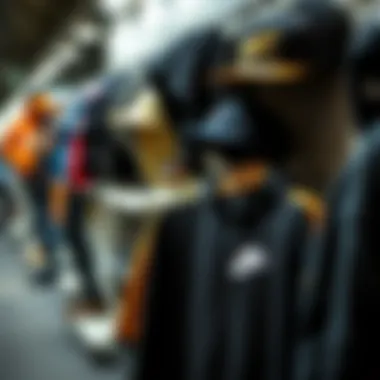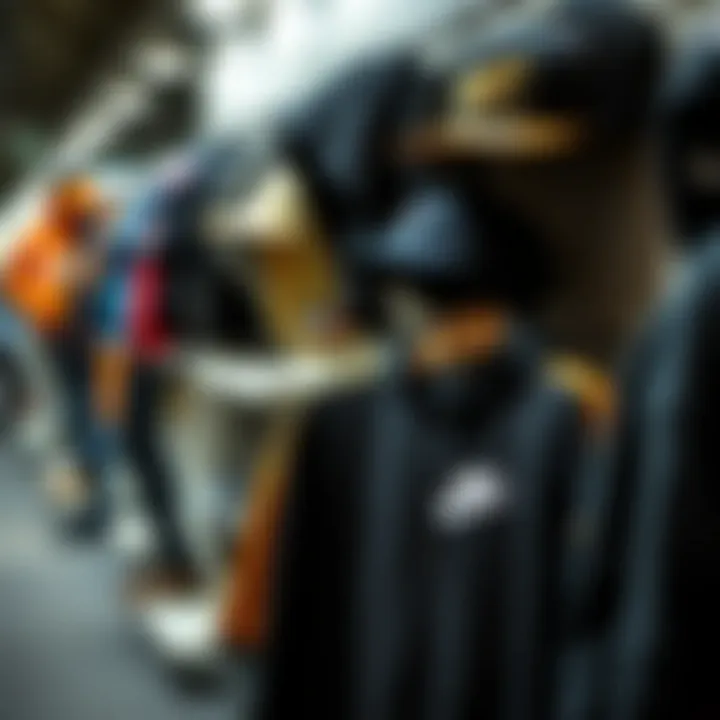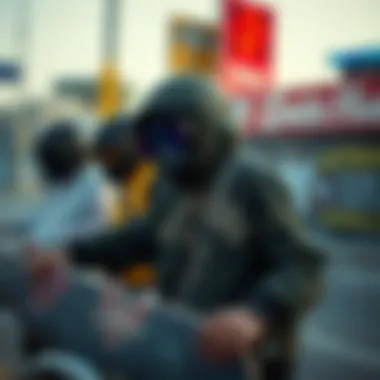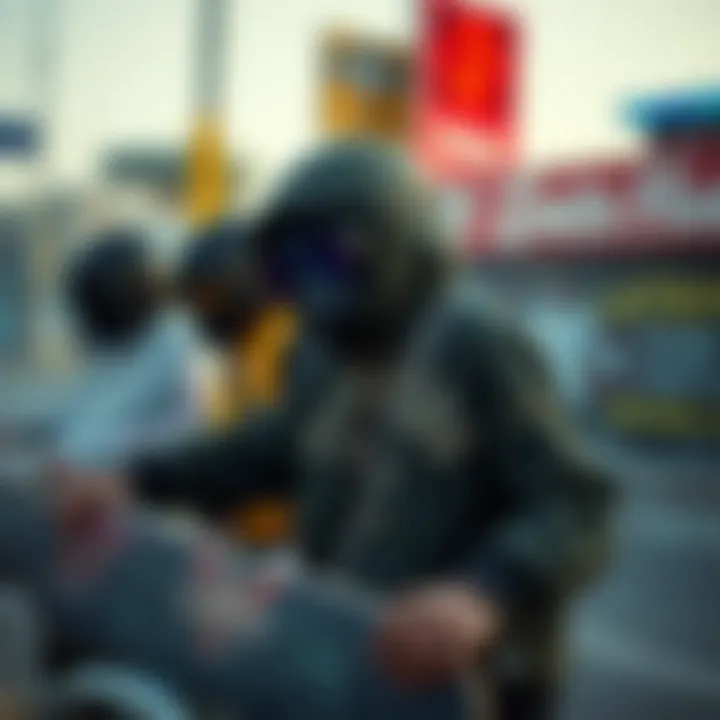The Evolution of Street Wear and Online Shopping


Intro
Street wear has come a long way from its roots in skate culture and urban environments. Nowadays, it’s not just a fashion statement; it’s a way of life, deeply intertwined with the digital landscape. The rise of online shopping has revolutionized how enthusiasts and casual fans alike access and engage with street wear. It's fascinating to observe the evolving nature of this genre, especially as consumer preferences shift in the face of rapid globalization and technological advances.
In this article, we will explore the nuances of street wear's evolution along with the ascension of online shopping. The discussion will include not only the characteristics that define street wear culture but also the implications these changes have on buyer behaviors. We’ll look at the challenges and opportunities that arise within the space, touching on critical issues like authenticity and sustainability.
Skills Development
Street wear isn’t just about garments; it’s about skills and individual expression. Understanding how to navigate the online platforms where this culture thrives can significantly enhance your experience as both a consumer and a participant in the scene. From selecting the right brands to mastering styling techniques, the following points will help you sharpen your skills.
Trick Tutorials
In the realm of street wear, tricks don’t just refer to skateboarding moves; they also encompass style tricks that can elevate one’s fashion game. Engaging with online tutorials can be a game-changer. Many platforms have dedicated channels for everything from thrifting hacks to layering techniques that really make an outfit pop.
- Research: Dive deep into local thrift stores and consignment shops. Often, unique pieces can be found that speak to your personal style.
- Layer Up: Master the art of layering for that effortlessly cool look. Start with a basic tee, add a hooded sweatshirt, and finish off with a denim or bomber jacket.
- Accessorize Thoughtfully: Don’t underestimate the power of accessories. A simple cap or statement necklace can instantly transform your outfit.
Skill Progression Tips
Developing your street wear ensemble isn't a race; it's about finding what resonates with you. Here are some progressive tips for cultivating a distinctive style:
- Follow the Trends: Keep an eye on fashion influencers on platforms like Instagram and TikTok. They often set the stage for what’s hot.
- Experiment: Allow yourself the freedom to try new pairings and combinations. Don't be afraid to mix high-end with street brands.
- Invest in Staples: While staying trendy is important, having a few quality staples in your closet can serve as a solid base for various looks.
"Street wear is more than just clothes; it's a canvas for personal expression."
Gear Insights
When it comes to street wear, gear matters—especially for those who engage in skateboarding or other urban activities. Not only do the right shoes and boards affect performance, but they also play a key role in personal style.
Skateboard Reviews
The skateboard itself often reflects a skater's identity. The emergence of online platforms has made it easier to research and purchase skateboards that fit your style and needs. Here’s a rundown of brands worth considering:
- Element: Known for their quality decks and eco-friendly initiatives.
- Baker: Offers durable boards that are favoured by many in the skate community.
- Santa Cruz: Iconic graphics that make a statement both on and off the board.
Safety Equipment Recommendations
Safety should never take a backseat in street sports. Here’s what you should consider:
- Helmets: Always invest in a good-quality helmet. Brands like Pro-Tec have long been the go-to choice for many skaters.
- Pads: Knee and elbow pads can save you from nasty spills. Brands like Triple Eight offer a good range.
In the realm of street wear, the significance of this gear cannot be overstated. It not only serves functional purposes but becomes a part of the culture that’s reflected in your look.
As we delve deeper into this article, we will continue unwrapping the complex layers of how street wear melds with online shopping, shaping the future of fashion in urban culture.
Prolusion to Street Wear
Street wear has transformed remarkably over the past few decades, evolving from a niche segment to a dominant player in contemporary fashion. The significance of understanding street wear goes beyond mere aesthetics; it's about grasping how this unique style reflects the lives, beliefs, and trends of various communities. In an era where online shopping dominates, the marriage of these two worlds provides endless avenues for exploration and innovation.
In this article, we will delve into the special features that make street wear not just a fashion statement, but a cultural phenomenon. From its roots in urban styles to its widespread acceptance in global fashion, street wear serves as a canvas for self-expression.
Defining Street Wear
Street wear encompasses a variety of styles and influences, often rooted in youth culture and the rebellious spirit of subcultures like skateboarding, hip-hop, and punk. It is characterized by its comfort and functionality, often employing graphic tees, oversized silhouettes, and accessories that resonate with the everyday lives of the wearers.
To define street wear is to acknowledge its fluidity; it adapts to changes in society and captures the sentiments of the youth. It’s not just about the clothing, but the conversations they spark and the connections they create. Street wear represents a voice, a movement, and a lifestyle that defies the conventions of high fashion.
Historical Context and Origins
The birth of street wear can be traced back to the late 20th century, when brands like Stüssy and Supreme began to merge skate culture with high-end fashion. These companies recognized the potential of marketing to a demographic that was increasingly drawn to unique and limited-edition products. The culture grew in the streets of Los Angeles and New York, where the aesthetics of hip-hop and skateboarding converged, giving rise to a distinct fashion narrative.
As street wear gained traction, it became synonymous with iconography and rebellion. In the late 1990s, graffiti artists and musicians emerged as ambassadors for the street wear philosophy, and their influence was felt in the rapidly evolving landscape of consumer culture.
Cultural Influences on Street Wear
Street wear is deeply intertwined with various cultural elements, making it a rich tapestry of influences. Music, particularly genres like hip-hop and punk, plays a pivotal role in shaping trends. Rappers such as Kanye West and Travis Scott have seamlessly blended music with fashion, establishing themselves as style icons who inspire countless fans.
Furthermore, art forms like graffiti have left an indelible mark on street wear designs. Collaborations with famous artists often see street wear brands pushing boundaries and reaching new audiences.
In addition to music and art, social unrest and movements have inspired street wear collections, amplifying messages that resonate with a broader audience. Whether it's advocating for social justice or environment consciousness, street wear brands often embody a critique of the status quo, encouraging wearers to challenge societal norms.
In summary, the realm of street wear is complicated and multifaceted. As we navigate through the evolution of street wear alongside the rise of online shopping, we will uncover the nuances that define this ever-changing landscape.


The Rise of Online Shopping for Street Wear
The rise of online shopping for street wear has transformed how consumers interact with fashion completely. It has opened the floodgates for creativity and innovation within the scene. No longer confined to physical stores, street wear enthusiasts now have access to a global market right at their fingertips. This shift has significant implications for how styles develop and how brands communicate with their fans.
Transition from Brick-and-Mortar to Digital
A significant part of the rise of online shopping stems from the gradual transition from traditional brick-and-mortar stores to digital platforms. Many street wear brands once relied solely on storefronts to generate sales. Think of those mom-and-pop shops filled with skateboards and trendy tees. They provided a sensory experience—a chance to touch fabrics, try on items, and feel the atmosphere. However, with technology climbing to the forefront, the consumer landscape began to shift.
Now, shoppers can browse an endless array of products, view online catalogs, and complete purchases with just a few clicks. For instance, platforms like Supreme and Off-White have built massive online presences, streamlining their exclusivity while also expanding their reach. Moreover, the recent pandemic accelerated this shift, pushing even the most loyal store-goers to embrace digital shopping. It feels like a slow-moving avalanche transforming how people think about street fashion.
The Impact of Social Media
Social media has had a monumental impact on street wear and its online shopping experience. Platforms such as Instagram, TikTok, and Pinterest serve as virtual billboards, promoting the latest trends and upcoming drops. Influencers and brand collaborations flourish in these spaces, allowing new designers to showcase their work and reach potential customers in a way that wasn't possible before.
Illustrating this point further, many brands now drop collections in coordination with widely followed figures. A post on Instagram with a popular influencer wearing a rare hoodie can spark frenzy among fans, sometimes leading to items selling out within minutes. The engagement on these platforms creates community, inviting conversation around styles and preferences, ultimately influencing purchasing decisions.
"Social media is the megaphone for street wear culture. It has turned hype into a digital currency, fueling consumer demand like never before."
Shifting Consumer Habits
As online shopping for street wear grows, consumer habits continually adapt alongside it. Shoppers today are no longer content to merely buy a product; they seek a holistic experience. Aspects such as authenticity, brand story, and community engagement play pivotal roles in their decisions. The importance of storytelling cannot be understated. Consumers want to know why a brand exists and what it stands for, leading them to favor those that resonate with their values.
Furthermore, the move towards sustainability has altered shopping behaviors. A growing deal of street wear fans now actively seek out brands that focus on ethical production and environmentally friendly practices. Many are even venturing into thrift stores or online resale platforms to find unique pieces while contributing to a circular fashion economy. While the obsessiveness of quick trends persists, there is a noteworthy shift towards conscious consumerism.
In short, the rise of online shopping for street wear doesn’t merely reflect a change in purchasing methods, but echoes a broader cultural shift in how consumers view the brands and items they choose. The digital landscape is here to stay, and its evolution is ripe for exploration.
Key Online Platforms for Street Wear Shopping
In the current retail climate, the importance of key online platforms for street wear shopping cannot be overstated. These platforms don't just serve as digital storefronts; they shape consumer experience, influence trends, and even contribute to brand identities. As more shoppers swap bricks and mortar for a click and scroll, understanding these platforms becomes essential for enthusiasts and industry professionals alike.
Dedicated Street Wear Websites
When it comes to street wear, dedicated websites play a pivotal role in curating any urban fashion experience. Brands such as Supreme and Palace have distinct online domains that showcase their unique aesthetics while offering limited drops that create urgency among buyers. The thrill in claiming a coveted piece is akin to a treasure hunt, with users refreshing pages and waiting for the launch of exclusive drops.
These dedicated websites often provide more than just purchase opportunities; they nurture a community through blog posts, fashion lookbooks, and social engagement. They're also a hub for brand storytelling, allowing consumers to connect with the ethos and history behind each collection. Take Stüssy, for example. Their website offers insights into the brand's skate culture roots, reinforcing loyalty among its customer base.
Marketplace Models
Marketplace models have emerged as formidable players in the street wear arena, bringing together a myriad of brands and styles under one virtual roof. Consider platforms like Grailed and StockX, where users can buy, sell, or trade items with fellow enthusiasts. These marketplaces emphasize transparency; prices are often backed by data analytics and real-time trends, offering buyers and sellers a fair chance at making knowledgeable decisions.
The real gem of marketplace models lies in their variety. Shoppers can explore thousands of different listings, ranging from high-end, hard-to-find releases to budget-friendly alternatives. This democratic approach not only affords consumers a chance to discover unique pieces but also gives rising street wear brands a platform to gain exposure. Beyond the purchase, though, there's an inherent community aspect, where peers can discuss styles, trends, and even organize meet-ups.
Influencer Collaboration Platforms
In today's hyper-connected world, influencer marketing has become a defining characteristic of how street wear is sold online. Platforms that facilitate collaborations between brands and influencers can massively amplify reach and engagement. Look at Instagram or TikTok; these platforms serve as battlegrounds for influencers to unveil new collections, often partnering with brands for limited-edition teasers.
The beauty of these collaborations lies in their authenticity. Influencers can speak directly to their followers, creating a narrative that transcends simple promotional activities. For instance, a partnership between a skateboarding influencer and a street wear brand could result in a collection that showcases real-life use cases, resonating deeply with the audience. Such collaborations not only drive sales but also shape brand narratives and customer expectations.
"The fusion of street wear and influencer collaboration creates a powerful marketing tool, bridging gaps between consumers and brands."
As we transition further into the digital shopping landscape, understanding the nuances of these key online platforms becomes vital for consumers and businesses. From dedicated sites providing rich brand narratives to marketplaces ensuring variety and influencer platforms driving engagement, each element plays a distinct role in shaping the street wear shopping experience.
Navigating the Online Street Wear Landscape
Navigating the world of online street wear can feel like stepping into a labyrinth, often filled with diverse choices and a multitude of brands. Understanding how to maneuver through this landscape is crucial for consumers, retailers, and even influencers who are part of this vibrant culture. The digital age has empowered skateboarding enthusiasts and aspiring shop owners alike, offering a platform to connect with like-minded individuals and find unique pieces that resonate with their personal style.
Authenticity and Brand Trust
In this digital shopping realm, brand authenticity arises as a core concern. Consumers want to ensure that the gear they're investing in is not only genuine but also a reflection of their values. With street wear brands often rooted in culture and community, discerning quality and authenticity can be tricky. The likes of Supreme and Off-White have built a foundation based on limited releases and exclusivity, which can sometimes create confusion in a market inundated with replicas.
Key Considerations for Authenticity:
- Official Collaborations: Recognizing partnerships with famous designers or brands can bolster trust. For instance, Nike's collaborations with Travis Scott have been greatly valued, considering their artistic integrity and authenticity.
- Third-party Certification: Some platforms have implemented systems to verify product authenticity through labelled tags or serial numbers.
- Brand History: Engaging with a brand’s narrative often reveals its commitment to quality. Researching a brand's evolution and ethos lays the groundwork of trust.
“In the world of street wear, credibility often hangs on the authenticity of a brand.”
Understanding Size and Fit
Size and fit can vary significantly across different brands, and navigating these discrepancies can pose quite the challenge for online shoppers. This is especially true with street wear styles, where oversized or tailored fits can dramatically alter the overall look. It's important for consumers to have a clear understanding of sizing to avoid the all-too-common buyer’s remorse that comes with inappropriate fits.
Strategies for Navigating Size:
- Size Charts: Many brands provide detailed size charts that take into account both dimensions and style. Utilize these before making a decision.
- Community Feedback: Engaging in forums can provide insights from fellow buyers regarding fit accuracy. Websites like Reddit have robust discussions on this subject where users share their personal experiences.
- Try Before You Buy: Some online shops offer virtual fitting rooms or exchange policies that allow customers to try on items at home. If searching for a perfect fit, this could be a lifesaver.


Customer Reviews and Feedback
Customer reviews and feedback play a vital role in the online shopping experience. Unlike traditional retail, where one can physically touch and try items, online shopping relies heavily on previous customers to guide potential buyers. Reviews can provide useful insights into the product quality, fit, and even brand responsiveness.
The Importance of Reviews:
- Quality Assurance: Real-world experiences shared by previous buyers often highlight product durability—a critical factor when it comes to street wear pieces that endure an active lifestyle.
- Community Trust: Engaging customers through comment sections fosters a sense of community, where shoppers feel part of a larger narrative rather than isolated transactions.
- Influencer Impact: Influencers often shape perceptions about products. Their endorsements can either boost sales or deter customers based on their feedback. It's crucial that their opinions align authentically with their followers' tastes.
In sum, effectively navigating the online street wear landscape involves a multifaceted approach. Understanding authenticity, size considerations, and valuing customer reviews creates a framework that enhances the overall shopping experience, ensuring that the excitement of street wear remains alive and well amid digital transactions.
Finale
As retailers continue to innovate and adapt their strategies to meet consumer demands, staying informed about these components will serve as a beneficial roadmap for anyone involved in the world of street wear. Whether you're a skateboarder on the hunt for the latest gear or a shop owner refining your inventory, the landscape is rich with opportunities as long as you know how to navigate it.
The Role of Community in Street Wear Shopping
Community plays a pivotal part in the realm of street wear shopping, influencing both trends and consumer behavior. The shared passion among enthusiasts fosters a sense of belonging, which can be seen across different platforms. This communal aspect is vital, as it shapes the perception of brands and products, guiding buying decisions. When individuals feel they are part of a community, they are more likely to support brands that reflect their shared values and aesthetics, enhancing customer loyalty.
Engagement through Online Forums
Online forums serve as melting pots for street wear fans. Sites like Reddit and dedicated Facebook groups allow members to discuss their favorite brands, share styling tips, and even trade or sell items.
These platforms foster a sense of kinship, where newcomers can ask questions and get advice from seasoned collectors. Some benefits of engaging in these forums include:
- Access to exclusive drops: Many forums provide early notifications on upcoming releases, ensuring members don't miss out on limited editions.
- Authentic feedback: Users can share their experiences with specific products or brands, helping others make informed decisions.
- Networking opportunities: Members may find local meet-ups or collaborations, further cementing their ties to the street wear community.
Collaboration with Local Artists
Local artists play an integral role in breathing new life into street wear culture. When brands team up with local creatives, it creates a unique bond that's deeply rooted in community identity. These collaborations often lead to designs that reflect the authenticity and ethos of the area, making them more appealing to local consumers. Examples include limited edition sneaker releases featuring artwork that captures the spirit of their hometown.
Such partnerships illustrate the blend of art and commerce, adding value to products while also supporting local talent. Consumers tend to resonate with brands that prioritize local collaboration, which not only strengthens community ties but also elevates the overall aesthetic appeal of street wear.
Pop-Up Events and Collaborations
Pop-up events represent a vibrant avenue for community engagement in the street wear scene. These temporary retail spaces often serve as a stage for exclusive product launches, providing a platform where street wear enthusiasts can connect and experience the latest trends firsthand. Pop-ups often transcend traditional sales approaches, engaging consumers with immersive experiences like live music or art installations.
Such gatherings encourage:
- Face-to-face interactions: Meeting fellow fans and brand representatives helps build stronger connections.
- Immediate feedback: Brands can directly gauge consumer reactions, leading to potential refinements in their offerings.
- A sense of urgency: The fleeting nature of pop-up events compels consumers to act quickly, often leading to increased sales and customer engagement.
Overall, community plays a role that stretches beyond simple transactions in online street wear shopping. It nurtures relationships, encourages collaborations, and fosters a culture driven by shared interests and passions. Engaging with local artists and participating in community-driven events allows brands and consumers alike to strengthen their ties while enriching the street wear landscape.
Sustainability in Street Wear
Sustainability in street wear has emerged as a pressing theme that intertwines environmental concerns with the cultural relevance of fashion. As more individuals gain awareness about the negative impact of fast fashion, there's a growing demand for brands to adopt sustainable practices. The evolution of street wear in the e-commerce realm can no longer overlook these principles, making sustainability not only a moral stance but also a critical market differentiator.
Conscious Consumerism
The rise of conscious consumerism reflects a shift in priorities among shoppers, particularly within the street wear community. Nowadays, buyers are often looking beyond style and price tags. They wish to know where their clothes come from, how they are made, and who made them. This heightened awareness stems from various factors, including documentaries about environmental degradation and social media campaigns highlighting ethical issues.
For example, a small brand like Nudie Jeans, known for their commitment to organic cotton and fair labor practices, attracts customers who are mindful of their impact. Shoppers are likely to pay a premium for products that resonate with their values.
"To consume less but better has become a motto for many streetwear fans today."
Ethical Production Practices
Ethical production practices in street wear encompass transparency in the supply chain, fair wages, and safe working conditions for all workers involved, from design to delivery. Many brands are now eager to showcase their commitment to these standards. The irony, however, lies in the allure of street wear often stemming from its underground roots, which can clash with mass production models.
Brands such as Patagonia have stood out by emphasizing their ethical practices, so much so that they even encourage customers to repair their items instead of replacing them. This reevaluation of the traditional model calls for brands to reassess their values and rethink how they satisfy consumer desires while being responsible.
Second-Hand Market Growth
As new generations embrace sustainability, the second-hand market in street wear has arguably become a goldmine. Sites like Grailed and Depop have made it easier to buy and sell pre-loved garments, fostering an intrinsic sense of community among users. Here, buyers can find unique pieces that tell stories of personal expression while also reducing waste.
The appeal lies not just in saving money but also in the thrill of the hunt for rare or vintage items. For many skateboarders fond of unique styles, second-hand shops or online marketplaces have become trendy spots to discover distinct apparel that wouldn’t be found in conventional retail environements.
As shoppers embrace these principles, eco-friendly packaging, recycling initiatives, and brand take-back programs are gaining traction, further solidifying the second-hand environment as a sustainable alternative ranging from rare finds to basic essentials.
Challenges Faced by Online Street Wear Retailers
The domain of online street wear shopping is rife with complexities that retailers must navigate to remain relevant and profitable. As the shopping landscape evolves, the challenges faced by these retailers can shape not only their operational strategies but also influence customer experiences and buying decisions. The significance of addressing these challenges cannot be understated. It connects directly to how effectively brands can engage with consumers, maintain trust, and respond to market dynamics.


Competition Among Brands
In the bustling market of street wear, the competition is fierce. New brands pop up like weeds, often backed by influencers or limited-edition releases that capture the attention of dedicated fans. Existing players are not sitting idle, either; they continually innovate to keep their edge. The abundance of choices means that a consumer can easily shift loyalty at the drop of a hat.
For retailers, this means constantly refining their unique selling propositions. In order to stand out, brands must pay close attention to what resonates with their target demographic. This can involve everything from the materials used in clothing to the individual stories behind each collection. A retailer must also use impactful marketing strategies to accentuate their unique value without overwhelming potential buyers.
Counterfeit Goods Issue
Counterfeits are like the proverbial thorn in the side for many online retailers. The proliferation of fake street wear products can severely damage a brand’s reputation and cause customers to question authenticity. For high-end street wear labels, whose items are priced at a premium, consumers expect not just quality but also legitimacy. Counterfeit products can flood online marketplaces, making it urgent for retailers to develop practices that ensure they stand apart from these imitations.
Moreover, shoppers today are savvy and more informed, often doing their homework before any purchase. They seek out genuine reviews, pay attention to branding, and look for verified sellers. When a retailer can clearly communicate what makes their products authentic—whether through certifications or unique branding elements—they reassure consumers and help fend off doubts.
Retailers must also utilize technology to combat this issue. Implementing scanning or blockchain systems can help ensure product authenticity and origin tracking helping foster greater trust. Addressing counterfeits isn't simply a matter of business; it's about preserving the community and culture that street wear represents.
Logistical Hurdles
Logistics represent another mountain that online street wear retailers must scale. Efficiently processing orders from different geographical locations can be a daunting task. The complexities involved in managing inventory, delivery times, and return policies can lead to inefficiencies that might just frustrate customers enough to look elsewhere.
Additionally, with increasing demand for next-day or same-day delivery options prevailing among consumers, street wear retailers must devise tailored shipping strategies. Those lacking the infrastructure to handle rapid shipping can lose customers quickly as patience wears thin in an age fueled by immediacy.
To tackle these logistical challenges, retailers can benefit from gradually optimizing their supply chains. This might mean investing in better inventory management systems or forging partnerships with reliable courier services to facilitate faster deliveries. Retailers who are proactive in resolving these hurdles may not only meet customer expectations but truly enhance the overall shopping experience.
Navigating the challenges faced by online street wear retailers is no small feat. With competition becoming ever more intense, the specter of counterfeit goods looming, and logistical issues complicating fulfillment, brands must be innovative and resilient. Each hurdle, however, also represents an opportunity for differentiation, growth, and a deeper connection with the street wear community.
Future Trends in Online Street Wear Shopping
The landscape of street wear continues to shift, reflecting broader changes in consumer preferences and technological advancements. Understanding these future trends is crucial for skateboarding enthusiasts, skate shop owners, and anyone passionate about this vibrant culture. As online shopping becomes more prevalent, it opens up new avenues for self-expression, sustainability, and personalization in street wear.
The Role of Augmented Reality
Augmented reality (AR) is reshaping how consumers interact with street wear brands. Imagine being able to virtually try on sneakers or hoodies before committing to a purchase. This technology not only enhances the shopping experience but also allows for better decision-making, significantly reducing the likelihood of returns due to sizing issues. AR can create a more immersive environment, where shoppers can visualize how a piece fits into their existing wardrobe or complements their style. For instance, using a smartphone app, potential buyers can see how a limited-edition jacket looks in their mirror, tailored to their unique aesthetics.
The seamless integration of AR into online platforms is turning browsers into buyers, as they can physically engage with products in a virtual space. Brands like Nike and Adidas have already dabbled in AR, paving the way for further innovations.
Emergence of Niche Markets
As the street wear phenomenon matures, niche markets are bubbling to the surface. No longer is street wear confined to mainstream labels; independent designers and small brands are crafting unique identities that resonate with specific communities. Take, for instance, eco-friendly street wear targeted at environmentally conscious consumers or collaborations with specific cultures to celebrate diversity.
This trend isn't just a passing fad; it’s a reflection of changing consumer behavior. Younger generations crave authenticity and want their purchases to align with their values. As a result, brands focusing on unique messaging, exclusivity, and heritage are gaining traction. Small collective brands have the added advantage of fostering community feeling and loyalty among their customers.
Evolving Brand Collaborations
The partnerships between brands in the street wear sphere are evolving, shifting from one-off collaborations to more integrated partnerships that include long-term strategies. Collaborations are now diving deeper, involving co-creation and product development rather than merely slapping logos on products.
Take the collaboration between Supreme and Louis Vuitton; it wasn't merely a meeting of high fashion and street culture. Both brands tapped into each others’ strengths, resulting in items that not only sold out instantly but also redefined perceptions within their respective markets.
In the future, we’re likely to see even more innovative partnerships, where technology companies might collaborate with apparel brands to influence designs or functions in clothing, enhancing both fashion and usability. This could range from smart fabrics that adjust to temperatures to limited releases that emphasize social causes. Together, brands can create experiences that elicit emotional connections from consumers, thus bridging the gap between lifestyle and fashion even further.
"Staying up to date with trends isn't just about being trendy; it's about understanding the pulse of culture and community."
For more discussions on street wear and online shopping dynamics, feel free to explore platforms like Reddit and engage in ongoing conversations.
Closure and Implications
The intersection of street wear and online shopping reflects much more than just a trend. It signals profound shifts in how culture, identity, and commerce intertwine. As consumers become accustomed to the conveniences of e-commerce, the importance of understanding these developments is paramount. This article has explored the evolution of street wear, mapping the challenges and triumphs of online retail in this dynamic environment.
Street wear has transcended its origins, morphing into a powerful cultural force that resonates across diverse demographics. With the digital marketplace becoming the go-to space for purchases, the implications of this shift are far-reaching. Here's a closer look at some critical elements:
- Consumer Behavior: The way individuals shop for street wear has deeply changed, favoring online platforms where variety, convenience, and access to global trends prevail.
- Brand Authenticity: Establishing trust becomes fundamental in digital realms, as street wear enthusiasts seek authentic connections with brands. The push and pull between exclusive online drops and accessibility create an ongoing dialogue about brand integrity.
- Sustainability and Ethics: As consumers become more conscientious, ethical production practices are gaining momentum. Brands prioritizing sustainability not only resonate with shoppers but are setting a new standard in the industry.
Understanding these implications equips industry stakeholders with insights needed for navigating this ever-evolving landscape. From shop owners to designers, recognizing consumer preferences and market trends is key to aligning strategies in a way that engages and nurtures community.
Recap of Key Insights
In reviewing the journey of street wear in conjunction with online shopping, here are the primary takeaways:
- Cultural Evolution: Street wear has emerged from niche origins, establishing itself as a crucial player in mainstream fashion.
- E-Commerce Trends: The online shopping landscape for street wear is rich with opportunity, characterized by platforms that enhance user experience.
- Authenticity Matters: Consumers are increasingly discerning, valuing genuine brand interactions and transparent practices.
- Sustainability Concerns: Eco-friendly initiatives are no longer optional but essential in capturing the loyalty of today’s shoppers.
- Community Engagement: Online forums and social media have forged connections between brands and consumers that drive loyalty and advocacy.
These insights provide a roadmap for understanding the multifaceted nature of street wear in a digital age, shedding light on essential strategies that can guide future decisions in the marketplace.
The Future of Street Wear Shopping
Looking ahead, the future of street wear shopping is poised for remarkable transformation, driven by several emerging trends:
- Augmented Reality Shopping: As technology advances, integrating augmented reality will allow consumers to virtually try on clothes from the comfort of their homes, enhancing the shopping experience.
- Beyond Mainstream: Niche markets are taking center stage, catering to subcultures and specific interests, providing tailored merchandise that speaks directly to dedicated communities.
- Innovative Collaborations: Brands are expected to venture beyond traditional partnerships, exploring urban artistry, sustainability initiatives, and even tech integrations in innovative ways.
"Digital shopping for street wear isn’t just a transaction; it’s an experience that intertwines community, culture, and commerce."
As these trends unfold, shop owners and designers can leverage this knowledge to remain agile, ensuring that their offerings not only resonate with current demands but also anticipate future shifts. The dialogue between culture and commerce will continue to shape the evolution of street wear as it seamlessly integrates with online shopping.



